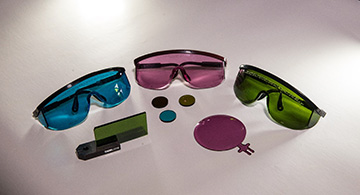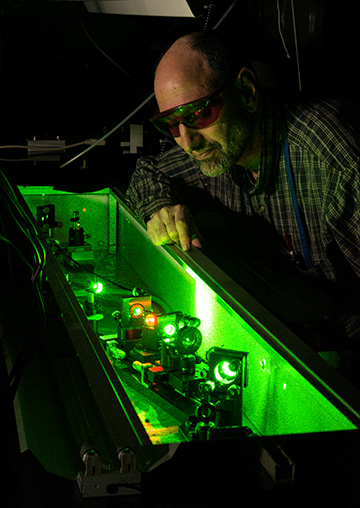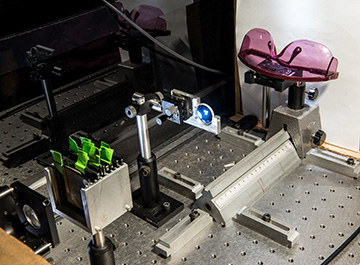
[Image: Courtesy of NIST]
Lasers with pulse widths shorter than 100 fs are opening new application spaces in science, biomedicine and industry. But researchers from the U.S. National Institute of Science and Technology (NIST) and Hood College, Md., USA, have issued a warning: The protective eyewear you’re using for ordinary laser work might not be up to the task of safeguarding vision from these ultrafast, high-peak-power lasers.
In recent tests of 24 protective-filter samples from five separate eyewear manufacturers, the NIST scientists found that a variety of them fell far short of their printed specification for optical density (OD)—in essence, light-blocking power—when handling light from ultrafast lasers (J. Laser Appl., doi: 10.2351/1.5004090). And even some those that performed according to their OD specifications for a given wavelength fell off sharply in effective OD for light only a few tens of nanometers away on the spectrum.
Those results underscore the need for scientists and technicians alike to understand the precise wavelengths their lasers are producing, and to select and test their eyewear carefully, in the emerging world of femtosecond pulses.
Powerful, broadband sources
Underlying the problem are some significant differences between continuous-wave (CW) and pulsed lasers. One is sheer power: high-peak-power femtosecond lasers can deliver irradiances on the order of terawatts or even petawatts per square centimeter (see “High-Average-Power Petawatt Lasers,” OPN, October 2017). Those peak powers, even lasting for less than a trillionth of a second, can saturate and overwhelm the organic dyes used in eye-protective filters that would easily handle light from a lower-power CW source.
Another difference lies in what the researchers call the “naturally broadband nature” of pulsed sources. While linewidths of CW lasers tend to be extremely sharp, the output intensity spectrum of a short laser pulse might be smeared out across 50 nm or more on either side of its center wavelength. That’s important, because a filter tuned to block light from a specific wavelength might prove far less effective in blocking light from only a few tens of nanometers away on the spectrum.
Checking the filters

OSA Fellow Edwin Heilweil of NIST. [Image: Courtesy of NIST]
To evaluate what they called “potentially dangerous eye safety situations when employing ultrafast lasers,” the research team, led by OSA Fellow Edwin Heilweil at NIST, started out by obtaining samples of protective filters rated as protective for a wavelength of 800 nm from five different eyewear manufacturers. They then fired laser pulses on the order 40 fs in width from a Ti:sapphire laser with a center wavelength of 800 nm, but tunable between center wavelengths ranging from 780 to 850 nm, at the samples, measuring the light transmitted through them using a fast silicon photodiode.
With the transmitted-light data in hand, the researchers calculated the OD values for the filter samples at a number of output wavelengths, ranging from 789 nm to 850 nm. Since OD is a common-log scale related to the transmitted power, a one-point difference in OD reflects a tenfold difference in transmitted power. For example, a filter with an OD of 5 blocks 100 times more light than a filter with an OD of 3.
The researchers found some significant discrepancies between the claimed OD values from the manufacturers, and the values from the actual tests using a femtosecond source. In a particularly extreme case, a filter claiming an OD of greater than 5 for light at 800 nm had a measured OD of 1.13—that is, transmitted nearly 10,000 times more light than the manufacterer’s spec implied—when the light came from the pulsed fs source. The light-blocking capabilities of other filters, while strong at the 800-nm center wavelength, fell off quickly for light as little as 8 nm away from that center value.
Message: Caveat emptor

In the tests, NIST and Hood College scientists fired femtosecond pulses at center frequencies near 800 nm through eyewear samples, and measured the transmitted light using a silicon photodiode (not shown). [Image: Courtesy of NIST]
Heilweil and the team were quick to point out that some of the test samples “fared extremely well” across the full range of wavelengths, powers and bandwidths. But others, the scientists reported, had measured OD values that were “inexplicably low,” and still others incurred actual damage at particularly high power levels.
Taken in total, the results suggest a potential eye-safety minefield as femtosecond lasers become more common in biomedicine, imaging, materials processing, micromachining and other applications. In light of that, the researchers offer some straightforward advice: caveat emptor.
“To provide adequate eye protection in femtosecond laser labs and commercial environments,” the researchers write, “utmost care must be taken to analyze the specific spectral content of the laser source”—and to choose the eyewear accordingly. And because laser sources and output conditions for individual labs and applications can differ in countless small ways, the researchers add, “we strongly suggest wherever possible, that filter materials should be directly tested by the end user for the application and conditions in question.”
Heilweil, quoted in a press release, elaborated on the point. “We are trying to encourage manufacturers to use the best possible testing laboratories to evaluate their lenses,” he said. And, equally important, end users “need to test their eyewear themselves—in the specific conditions and particular applications for which they will be used—before putting them on.”
